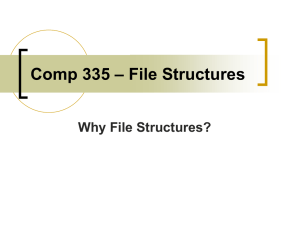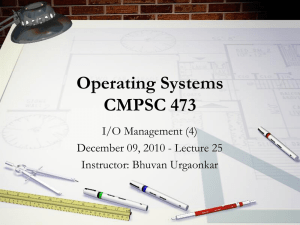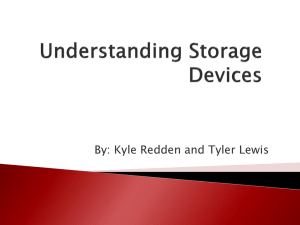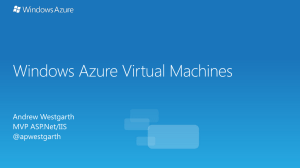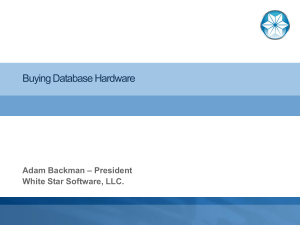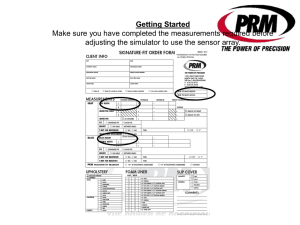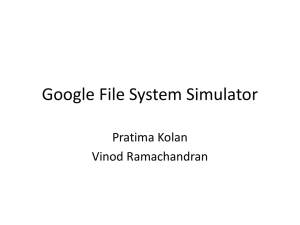Presentation
advertisement
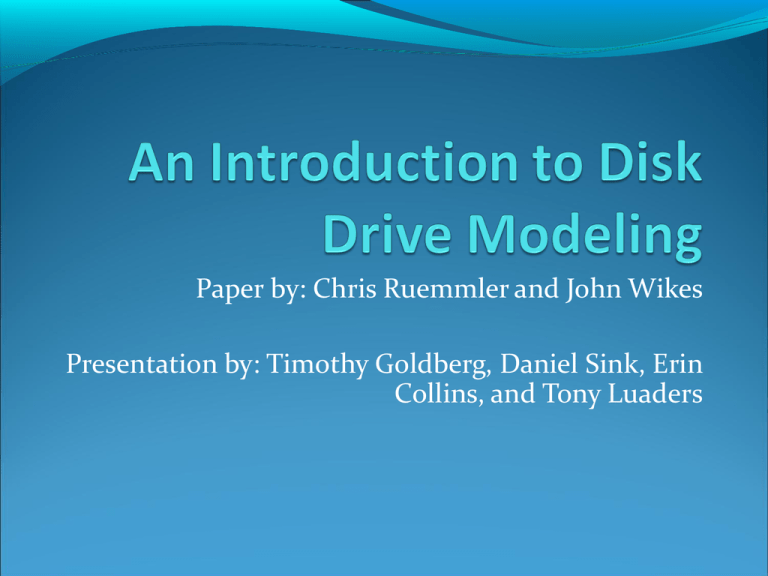
Paper by: Chris Ruemmler and John Wikes Presentation by: Timothy Goldberg, Daniel Sink, Erin Collins, and Tony Luaders Introduction Disk Drive performance improvements at 7-10% Compared to microprocessors at 40-60% or disk storage capacities at 60-80% (annually) Simulation models to compare alternative approaches High quality disk drive model Error factor 14 times smaller Outline Introduction Characteristics of Modern Disk Drives Recording Components Positioning Components Disk Controller Modeling Disk Drives Characteristics of Modern Disk Non-removable magnetic disk drives Contain a mechanism and controller Recording Components: rotation disks and heads Positioning Components: moves heads into correct position with track-following system Emphasis on features that could be important when creating a disk drive model Recording Components Smaller disks: Less surface area for data Less power consumption Can spin faster Smaller seek distances Increased storage density: Better linear recording density, maximum rate of flux changes Packing separate tracks of data more closely together May contain from 1 to 12 platters Stack rotates in lockstep Recording Components Spindle rotation speed: Higher spin speed increases transfer rates, shortens rotation latencies Higher power consumption, requires better bearings Each platter surface has a disk head Responsible for recording (writing) And sensing (reading) magnetic flux variation Single Read-Write data channel Can be switched between the heads Responsible for encoding and decoding data stream into or from a series of magnetic phase changes stored on the disk Disk Drive Positioning Components Data surfaces are set up to store data in tracks Modern disks have about 2,000 cylinders and are 3.5 inches. Cylinder is a single stack of tracks at a common distance from the spindle To access the data stored on a track, the disk arms must rotate all the disks to get the desired track to the disk head. This system ensures that the track is reached even with interruptions External vibrations, shocks, and disk flaws (non circular tracks) Seeking The speed of head movement Faster seeking requires more power Half the seek time requires 4x power Seek is composed of: Speedup (arm moves until at half seek distance) Coast (for long seeks, max velocity) Slowdown (rest close to desired track) Settle (puts disk head on desired location) Track Following Fine-tuning the head position at the end of the seek and keeping the head on the desired track Determines if head is correctly aligned by using positioning information on the disk at manufacturing time Performs head switches When the controller switches its data channel from one surface to the next in the same cylinder Data layout A disk appears to its client computer as a linear vector of addressable blocks which are mapped to physical sectors on the disk. Using this method, the disk can hide bad sectors and do low-level performance optimizations. Zoning: tracks are longer at the outside of a platter than at the inside. Maximize storage capacity Track skewing: faster sequential access across track boundaries Allows data to be read or written at nearly full media speed Sparing: stores a list of flaws in the desk surface to be skipped The Disk Controller Mediates access to the mechanism Runs the track-following system Transfers data between the disk drive and the client Manages an embedded cache caching of requests Speed-matching buffer can be extended to include some form of caching for both reads and writes. Caches in disk drives are relatively small because of space limitations. Read-ahead: faster than seeking if the cache gets a hit Write caching: saves cache information Cache is volatile, losing its contents if power to the drive is lost Command queuing: allows for multiple outstanding requests at the same time Disk controller determines the best execution order, subject to additional host constraints. Modeling Disk Drives The Simulator • Based in C++ using a version of the AT&T tasking library • The Basic ideas are readily applicable to other simulation environments • The disk drive is modeled as two tasks and some additional control structures • Task one models the mechanism, including the head and platter (rotation) positions. • Task two, the direct memory access engine (DMA), models the SCSI bus interface and its transfer engine. The Simulator • The cache object buffers requests between two tasks and is used to manage the asynchronous interactions between the bus interface and the disk mechanism tasks. • The simulator can process about 2,000 I/Os per second on an HP9000 Series 800 Model H50 system • This allows 1 million requests to be serviced in approximately 10 minutes Evaluation • Took week long samples from a longer trace series of HP-UX (Unix) computer systems. • A metric to evaluate the models used a time distribution curve for the real drive and the model output and use the root mean square of the horizontal distance between these two curves. No modeling •Uses a constant fixed time for each I/O •A demerit factor that is 35% of the average I/O time •This model is not good A simple model •A better model requires: •A seek time linear with the distance •No head-settle effects or head-switching costs •A rotational delay •A fixed controller overhead •A transfer time linear with the length of request •demerit of 15% of a mean I/O time Modeling head-positioning effects •Determined which track and cylinder the request started on and where it ended •Added a fix cost of 2.5 ms for each head and track switch •Demerit of 6.2% of a mean I/O time Modeling rotation position •Calculate rotational latency by keeping track of rotational position of the disk •Account for spare sectors •A demerit of 2.6% of mean I/O time Modeling data caching •Uses both read-ahead and immediate reporting •Large disparity due to caching •50% of request are completed in 3ms or less •Demerit of 112% is not acceptable! Modeling data caching •Added aggressive readahead and immediate reporting to the model •Demerit is now only 5.7% of the mean I/O time Model summary •Careful modeling is neither too difficult nor too costly •A good model needs careful calibration and tuning •These features and others may become particularly important when a workload has large data transfers


